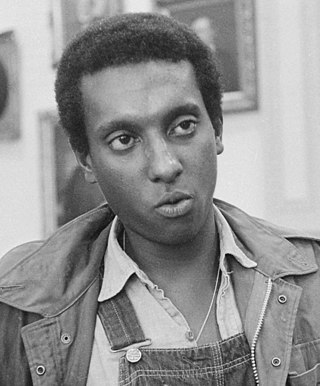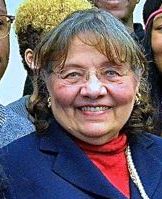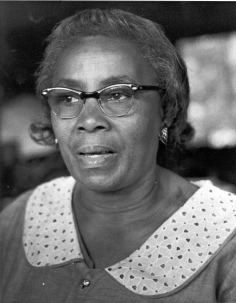
The civil rights movement was a social movement and campaign from 1954 to 1968 in the United States to abolish legalized racial segregation, discrimination, and disenfranchisement in the country. The movement had its origins in the Reconstruction era during the late 19th century and had its modern roots in the 1940s, although the movement made its largest legislative gains in the 1960s after years of direct actions and grassroots protests. The social movement's major nonviolent resistance and civil disobedience campaigns eventually secured new protections in federal law for the civil rights of all Americans.

The Student Nonviolent Coordinating Committee was the principal channel of student commitment in the United States to the civil rights movement during the 1960s. Emerging in 1960 from the student-led sit-ins at segregated lunch counters in Greensboro, North Carolina, and Nashville, Tennessee, the Committee sought to coordinate and assist direct-action challenges to the civic segregation and political exclusion of African Americans. From 1962, with the support of the Voter Education Project, SNCC committed to the registration and mobilization of black voters in the Deep South. Affiliates such as the Mississippi Freedom Democratic Party and the Lowndes County Freedom Organization in Alabama also worked to increase the pressure on federal and state government to enforce constitutional protections.

Kwame Ture was an American organizer in the civil rights movement in the United States and the global pan-African movement. Born in Trinidad, he grew up in the United States from the age of 11 and became an activist while attending the Bronx High School of Science. He was a key leader in the development of the Black Power movement, first while leading the Student Nonviolent Coordinating Committee (SNCC), then as the "Honorary Prime Minister" of the Black Panther Party (BPP), and last as a leader of the All-African People's Revolutionary Party (A-APRP).
The Mississippi Freedom Democratic Party (MFDP), also referred to simply as the Freedom Democratic Party, was an American political party that existed in the state of Mississippi from 1964 to 1968, during the Civil Rights Movement. Created as the partisan political branch of the Freedom Democratic organization, the party was organized by African Americans and White Americans sympathetic to the Civil Rights Movement from Mississippi to challenge the established power of the state Mississippi Democratic Party, which at the time opposed the Civil Rights Movement and allowed participation only by Whites, despite the fact that African Americans made up 40% of the state population.

Freedom Summer, also known as the Freedom Summer Project or the Mississippi Summer Project, was a volunteer campaign in the United States launched in June 1964 to attempt to register as many African-American voters as possible in Mississippi. Blacks had been restricted from voting since the turn of the century due to barriers to voter registration and other laws. The project also set up dozens of Freedom Schools, Freedom Houses, and community centers such as libraries, in small towns throughout Mississippi to aid the local Black population.

The Southern Christian Leadership Conference (SCLC) is an African-American civil rights organization based in Atlanta, Georgia. SCLC is closely associated with its first president, Martin Luther King Jr., who had a large role in the American civil rights movement.

The March Against Fear was a major 1966 demonstration in the Civil Rights Movement in the South. Activist James Meredith launched the event on June 5, 1966, intending to make a solitary walk from Memphis, Tennessee, to Jackson, Mississippi via the Mississippi Delta, starting at Memphis's Peabody Hotel and proceeding to the Mississippi state line, then continuing through, respectively, the Mississippi cities of Hernando, Grenada, Greenwood, Indianola, Belzoni, Yazoo City, and Canton before arriving at Jackson's City Hall. The total distance marched was approximately 270 miles over a period of 21 days. The goal was to counter the continuing racism in the Mississippi Delta after passage of federal civil rights legislation in the previous two years and to encourage African Americans in the state to register to vote. He invited only individual black men to join him and did not want it to be a large media event dominated by major civil rights organizations.
James Forman was a prominent African-American leader in the civil rights movement. He was active in the Student Nonviolent Coordinating Committee (SNCC), the Black Panther Party, and the League of Revolutionary Black Workers. As the executive secretary of SNCC from 1961 to 1966, Forman played a significant role in the Freedom Rides, the Albany movement, the Birmingham campaign, and the Selma to Montgomery marches.

Diane Judith Nash is an American civil rights activist, and a leader and strategist of the student wing of the Civil Rights Movement.

Robert Parris Moses was an American educator and civil rights activist known for his work as a leader of the Student Nonviolent Coordinating Committee (SNCC) on voter education and registration in Mississippi during the Civil Rights Movement, and his co-founding of the Mississippi Freedom Democratic Party. As part of his work with the Council of Federated Organizations (COFO), a coalition of the Mississippi branches of the four major civil rights organizations, he was the main organizer for the Freedom Summer Project.

Septima Poinsette Clark was an African American educator and civil rights activist. Clark developed the literacy and citizenship workshops that played an important role in the drive for voting rights and civil rights for African Americans in the Civil Rights Movement. Septima Clark's work was commonly under-appreciated by Southern male activists. She became known as the "Queen Mother" or "Grandmother" of the Civil Rights Movement in the United States. Martin Luther King Jr. commonly referred to Clark as "The Mother of the Movement". Clark's argument for her position in the Civil Rights Movement was one that claimed "knowledge could empower marginalized groups in ways that formal legal equality couldn't."
Annie Bell Robinson Devine (1912–2000) was an American activist in the Civil Rights Movement.
Victoria Jackson Gray Adams was an American civil rights activist from Hattiesburg, Mississippi. She was one of the founding members of the influential Mississippi Freedom Democratic Party.
The Council of Federated Organizations (COFO) was a coalition of the major Civil Rights Movement organizations operating in Mississippi. COFO was formed in 1961 to coordinate and unite voter registration and other civil rights activities in the state and oversee the distribution of funds from the Voter Education Project. It was instrumental in forming the Mississippi Freedom Democratic Party. COFO member organizations included the National Association for the Advancement of Colored People.
The Albany Movement was a desegregation and voters' rights coalition formed in Albany, Georgia, in November 1961. This movement was founded by local black leaders and ministers, as well as members of the Student Nonviolent Coordinating Committee (SNCC) and the National Association for the Advancement of Colored People (NAACP). The groups were assisted by Martin Luther King Jr. and the Southern Christian Leadership Conference (SCLC). It was meant to draw attention to the brutally enforced racial segregation practices in Southwest Georgia. However, many leaders in SNCC were fundamentally opposed to King and the SCLC's involvement. They felt that a more democratic approach aimed at long-term solutions was preferable for the area other than King's tendency towards short-term, authoritatively-run organizing.
Crusade for Citizenship was the 1958 voter project organized by the Southern Christian Leadership Conference (SCLC). The goal of the project was to double the number of African-American voters in the southern United States for the 1958 and 1960 elections. It was initially organized by Ella Baker as Associate Director of the SCLC, and Reverend John Tilley as the first Executive Director. While encouraging discussion and actions related to voter registration, it did not meet its goal of creating a mass movement. Southern registrars resisted registering African Americans and many blacks were reluctant or fearful to challenge existing exclusions under Jim Crow society.
Ralph Edwin King Jr., better known as Ed King, is a United Methodist minister, civil rights activist, and retired educator. He was a key figure in historic civil rights events taking place in Mississippi, including the Jackson Woolworth’s sit-in of 1963 and the Freedom Summer project in 1964. Rev. King held the position of chaplain and dean of students, 1963–1967, at Tougaloo College in Jackson, Mississippi. At this critical juncture of the civil rights movement, historian John Dittmer described King as “the most visible white activist in the Mississippi movement.”
Barbara Ransby is a writer, historian, professor, and activist. She is an elected fellow of the Society of American Historians, and holds the John D. MacArthur Chair at the University of Illinois Chicago.

Sandra Cason Hayden was an American radical student activist and civil rights worker in the 1960s. Recognized for her defense of direct action in the struggle against racial segregation, in 1960 she was an early recruit to Students for a Democratic Society (SDS). With Student Nonviolent Coordinating Committee (SNCC) in Mississippi, Hayden was a strategist and organizer for the 1964 Freedom Summer. In the internal discussion that followed its uncertain outcome, she clashed with the SNCC national executive.

African American women played a variety of important roles in the civil rights movement. They served as leaders, demonstrators, organizers, fundraisers, theorists, formed abolition and self-help societies. They also created and published newspapers, poems, and stories about how they are treated and it paved the way for the modern civil rights movement. They were judged by the color of their skin, as well as being discriminated against society because they are women. African American women faced two struggles, both sexism and racism. Womanism fully encompasses the intersectionality between these two social barriers, thus encompassing African American female involvement in the civil rights movement. African American women led organizations and struggles for their suffrage, anti-lynching laws, full employment and especially against the Jim Crow Laws. They had to constantly fight for equality and needed to have a voice in what they can do in society. Black women served a special role as "bridge leaders," forming connections between those in formal positions of power and political constituents. They were the middle person going back and forth between the two groups and provided information to them. African American women actively participated in community organizing and took on informal leadership roles, making substantial grassroots contributions to the movement. They were essential in energizing the neighborhood, planning activities, and building relationships between neighbors. Black women provided crucial safe spaces for activists to plan, strategize, and discuss important problems by hosting meetings and gatherings in their homes. When coordinating activities was not safe or feasible in public locations, this kind of grassroots involvement was especially crucial. The experiences of Black women during the CRM were more nuanced due to the confluence of gender and race. They had to navigate issues of race and gender, and they occasionally encountered prejudice inside the civil rights movement as well as in larger society. Notwithstanding these obstacles, African American women persevered in their endeavors, making a substantial contribution to the movement's eventual triumph. Their leadership and activity opened doors for later generations and demonstrated how important it is to acknowledge and value the diverse roles that Black women have played in the struggle for racial justice and equality. A major turning point was the Montgomery Bus Boycott of 1955, which followed Rosa Park's bold move of not giving up her bus seat. Several notable African American female activists and organizations emerged from this movement, making essential gains in the civil rights agenda, despite restricted access to power and the Cold War atmosphere pushing for silence within the United States.












